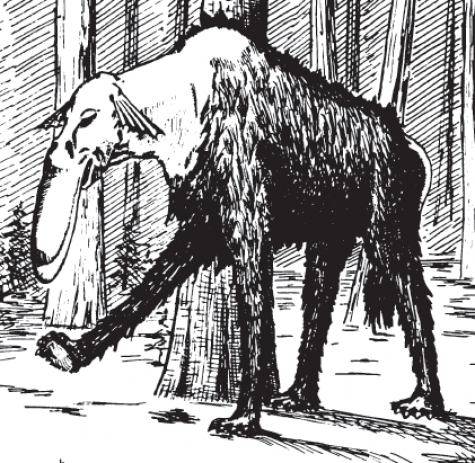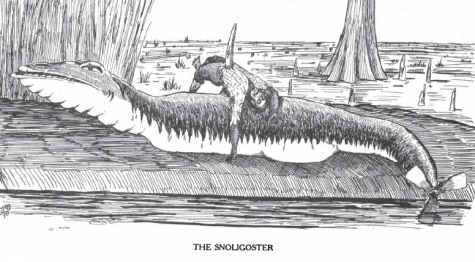
Allow me to introduce you to the hugag, a moose-like creature native to Minnesota, Wisconsin, and eastern Canada. “Its head and neck are leathery and hairless; its strangely corrugated ears flop downward,” wrote William Cox, the first state forester of Minnesota. “Its four-toed feet, long bushy tail, shaggy coat and general make-up give the beast an unmistakably prehistoric appearance.”
According to Cox, the enormous but mild-mannered hugag has a “perfect mania for traveling,” perhaps because of its jointless legs, which make it impossible to sit or lie down. The last known hugag sighting was in the early 1900s, when an 1,800-pounder was found stuck in the mud near Turtle River, Minnesota. (“It was knocked in the head by Mike Flynn, of Cass Lake,” Cox reported.)
William Cox was a busy man. In the 1910s he organized the Minnesota Forest Service, creating a badly-needed corps of wildland firefighters, surveying the state’s extensive woodlands, and establishing a state forest-reserve system. When the U.S. Congress passed a bill preventing President Roosevelt from expanding U.S. Forest Service lands in western states, Cox suggested to the nation’s chief forester, Gifford Pinchot, that Roosevelt make a large last-minute addition to the system. (Roosevelt took Cox’s advice, adding 16 million acres to the nation’s forest reserves just before signing the Congressional bill into law.) As state forester, Cox criticized Minnesota’s get-rich-quick approach to timber sales; when his reform efforts got him fired in 1924, he went to Brazil and organized a forest service there. By the time he returned to Minnesota in 1931, the state had conceded the argument and directed state foresters to manage the woods for the long term.
Somewhere in there, Cox encountered the hugag. And the snoligoster (which “resembles a huge crocodile, but is covered with long, glossy fur and has no legs or fins, except for one long spike on its back”). And the wapaloosie (a creature “about the size of a sausage dog” which “lives on shelf fungus and conchs exclusively”). And the whirling whimpus, the billdad, and the tripodero. Fearsome Creatures of the Lumberwoods, Cox’s charming fantasy field guide, is a mix of anthropology and foolery—and, above all, a tribute to the imaginative lumbermen who worked Cox’s beloved woods. Some of the animals were meant to scare greenhorns, others to relieve irritation (the slide-rock bolter drooled skid grease and tended to eat Colorado tourists). All were elusive and ephemeral, creations of a culture that Cox saw as living in rowdy coexistence with the woods. As logging became mechanized and its pace increased, the logger, his axe, and his tall tales became as endangered as the overexploited forest. Cox wrote:
whirling whimpus, the billdad, and the tripodero. Fearsome Creatures of the Lumberwoods, Cox’s charming fantasy field guide, is a mix of anthropology and foolery—and, above all, a tribute to the imaginative lumbermen who worked Cox’s beloved woods. Some of the animals were meant to scare greenhorns, others to relieve irritation (the slide-rock bolter drooled skid grease and tended to eat Colorado tourists). All were elusive and ephemeral, creations of a culture that Cox saw as living in rowdy coexistence with the woods. As logging became mechanized and its pace increased, the logger, his axe, and his tall tales became as endangered as the overexploited forest. Cox wrote:
The lumber regions are contracting. Stretches of forest that once seemed boundless are all but gone, and many a stream is quiet that once ran full of logs and echoed to the song of the river driver. Some say that the old type of logger himself is going extinct. It is my purpose in this little book to preserve at least a description and sketch of some of the interesting animals which he has originated.
Thanks to Cox, we still know the tracks of the hugag, the squonk, and even the tote-road shagamaw. And they—and we—have several million more acres of forest to haunt.
Illustrations of the hugag and the snoligoster by Coert Du Bois. From the original edition of Fearsome Creatures of the Lumberwoods, freely available here.
Tip of the hat to the children’s book Monsters and Legends for introducing me to Cox and his creatures.
One thought on “Fearsome Creatures of the Lumberwoods”
Comments are closed.